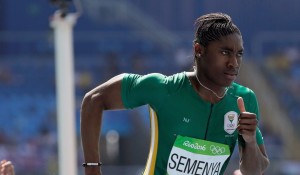Semenya questions are uncomfortable, unfortunate and unnecessary
“Nobody ever helps me into carriages, or over mud-puddles, or gives me any best place! And ain’t I a woman? Look at me! Look at my arm! I have ploughed and planted, and gathered into barns, and no man could head me! And ain’t I a woman? I could work as much and eat as much as a man – when I could get it – and bear the lash as well! And ain’t I a woman?”
— Former-slave-turned-abolitionist Sojourner Truth delivering her “Ain’t I a Woman?” speech at the Women’s Convention in Akron, Ohio in 1851.
South African runner Caster Semenya is making a similar argument, for different reasons, 165 years later. Questions about her are uncomfortable, unfortunate and unnecessary.
A favorite to win gold Saturday at the Rio Olympics in the 800 meters, Semenya has been forced to state her case since catapulting onto the scene in Berlin as an unknown teenager at the 2009 World Championships. The international track community publically and privately debated her very essence. That surely was a confounding and exceedingly painful ordeal for an 18-year-old from a rural village. But it was only the beginning.
“Just look at her,” Russia’s Mariya Savinova said after finishing fifth in Berlin. A writer in The New Yorker magazine used the term “breathtakingly butch” to describe Semenya.
She wasn’t cast into the spotlight solely because her appearance is much more masculine than traditionally feminine-looking women. Semenya became a controversial figure because her leaked sex-verification tests reportedly revealed that she had three times the amount of testosterone typically found in an average woman.
Performance-enhancing drugs weren’t to blame. Her “crime” is the natural result of hyperandrogenism, which creates abnormally high levels of testosterone in women. Semenya has never confirmed that she has the condition, but it’s the widely held belief of medical experts and others who have followed her case.
“I see it all as a joke,” Semenya told a South African magazine in 2009 regarding questions about her gender. “It doesn’t upset me. God made me the way I am and I accept myself. I am who I am and I’m proud of myself.”
Why shouldn’t she? She has done nothing wrong. She has worked and trained and sacrificed to be a world-class athlete, just like everyone else at the Olympics. Her efforts and ability have brought her close to breaking her event’s world record – track and field’s longest standing mark – set in 1983 by a previously mediocre 32-year-old Czech who miraculously (wink, wink?) transformed her body and her times.
Like Semenya, Jarmila Kratochvilova had a very masculine physique.
Unlike Semenya, Kratochvilova is encompassed by mountains of circumstantial evidence that she benefitted from the Eastern Bloc’s intricate doping program in the ‘70s and ‘80s. She never tested positive and her name wasn’t discovered in files that implicated some of her peers.
Kratochvilova consistently has denied using performance-enhancing substances.
That’s much more palatable than constantly denying you’re a man, which Semenya would do if she stooped to fearmongers’ level.
Track’s governing body was scared of athletes like Indian sprinter Dutee Chand, too. In April 2011, the International Association of Athletics Federations established “eligibility rules for females with hyperandrogenism,” allowing them to compete as long as their testosterone level fell within a certain range. They could use medication or surgery to comply, whatever it took.
Chand was barred from competing in 2014 due to reportedly being over the limit. But she won a legal challenge in the Court of Arbitration for Sport, which ruled that testosterone levels aren’t enough solely to prohibit women from entering women’s events.
The provisional victory – the IAAF was given two years to produce more scientific evidence – allowed Chand to race in Rio. She finished 59th out of the 64 runners in the 100 meters.
I guess testosterone alone isn’t enough to explain Semenya’s silver medal at the 2012 London Olympics.
It figures. Breaking down every single factor that separates champs from also-rans is impossible. Where’s the explanation for Katie Ledecky’s brilliance in the pool? What’s the reason for Simone Biles’ magnificence in the gym? How do we justify Diana Taurasi’s excellence on the court?
No one questions Ledecky, Biles or Taurasi because they pass the “eye test” as undoubtedly female. Meanwhile, athletes like Semanya and Chand are subjected to insensitive, intimate discussions about their private parts.
“I cried for three straight days after reading what people were saying about me” on the Internet, Chand, told the New York Times in 2014. “They were saying, ‘Dutee: Boy or girl?’ and I thought, how can you say those things? I have always been a girl.”
Men and women compete in separate events for a good reason, the roughly 10% difference between the sexes in athletic performance. But the only concern should be men masquerading as women – not women whose innate chemistry puts them at far ends of the spectrum.
Ain’t they women, too?
Yes, they most certainly are.
 Follow
Follow

